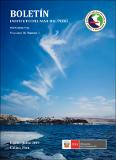Por favor, use este identificador para citar o enlazar este ítem:
https://hdl.handle.net/20.500.12958/3363Registro completo de metadatos
| Campo DC | Valor | Lengua/Idioma |
|---|---|---|
| dc.contributor.author | Chang, Flor | - |
| dc.contributor.author | Delgado Loayza, Elcira | - |
| dc.contributor.author | Bernales Jiménez, Avy | - |
| dc.contributor.editor | Instituto del Mar del Perú | - |
| dc.date.accessioned | 2019-09-10T19:56:08Z | - |
| dc.date.available | 2019-09-10T19:56:08Z | - |
| dc.date.issued | 2019 | - |
| dc.identifier.citation | Bol Inst Mar Perú. 34(1) 2019: p.35-48 | es_ES |
| dc.identifier.issn | 03787702 | - |
| dc.identifier.uri | https://hdl.handle.net/20.500.12958/3363 | - |
| dc.description.abstract | Se recolectaron 76 muestras utilizando una red de fitoplancton y 33 con botellas Niskin. Los volúmenes de plancton fluctuaron entre 0,08 y 10,7 mL.m-3, con media de 1,02 mLm-3. El fitoplancton estuvo restringido a 30 mn desde Pimentel hasta Atico y 200 mn frente a Pacasmayo. Estuvo conformado por diatomeas de fases tempranas e intermedias de la sucesión ecológica. Latitudinalmente, el mayor valor promedio fue localizado entre 6 y 7°S y dentro de 30 mn. Otros valores importantes fueron localizados entre 30 y 60 mn. Cuantitativamente, la mayor concentración estuvo en Chimbote (16.390 x103 cel.L-1) y la menor en Paita (33 x103 cel.L-1) con importante representatividad del nanoplancton. El ANOVA de dos vías, reportó diferencias significativas entre los volúmenes de plancton de acuerdo a distancias de costa (P<0,002; F= 8,53). La distribución de los indicadores biológicos denotó desplazamiento inusual de Ceratium breve var. schmidtii (AES) frente a Punta La Negra. Protoperidinium obtusum (ACF) estuvo restringido a la franja costera (20 mn) su distribución aumentó frente a Salaverry y Pacasmayo, Ceratium praelongum estuvo costero frente a Paita y asociado a AES más allá de 60 mn en Punta La Negra y frente a San Juan por fuera de 90 mn. | es_ES |
| dc.description.abstract | ABSTRACT: 76 samples were collected using a network of phytoplankton and 33 were collected with Niskin bottles. Plankton volumes ranged between 0.08 and 10.7 mL.m-3, with a mean of 1.02 mLm-3. Phytoplankton was restricted to 30 nm from Pimentel to Atico and 200 nm off Pacasmayo. It was formed by diatoms of early and intermediate stages of ecological succession. The highest mean value was latitudinally located between 6 and 7°S and within 30 nm, while other important values were located between 30 and 60 nm. In terms of quantity, the highest concentration was in Chimbote (16.390 x103 cel.L-1) and the lowest in Paita (33 x103 cel.L-1) with important representation of nanoplankton. The two-way ANOVA showed significant differences between plankton volumes based on coastal distances (P<0.002; F=8.53). The distribution of biological indicators evidenced the unusual displacement of Ceratium breve var. schmidtii (SEW) off Punta La Negra. Protoperidinium obtusum (CCW) was limited to the coastal strip (20 nm) and its distribution increased off Salaverry and Pacasmayo, while Ceratium praelongum was coastal off Paita and it was associated with SEW beyond 60 nm at Punta La Negra and off San Juan, outside 90 nm. | - |
| dc.language.iso | spa | es_ES |
| dc.publisher | Instituto del Mar del Perú | es_ES |
| dc.relation.ispartofseries | Boletín IMARPE;34(1), 2019 | - |
| dc.rights | info:eu-repo/semantics/openAccess | es_ES |
| dc.rights.uri | https://creativecommons.org/licenses/by/4.0/ | es_ES |
| dc.source | Instituto del Mar del Perú - IMARPE | es_ES |
| dc.source.uri | Repositorio Digital IMARPE | es_ES |
| dc.subject | Fitoplancton | es_ES |
| dc.subject | Nanoplancton | es_ES |
| dc.subject | Microplancton | es_ES |
| dc.subject | Primavera 2008 | es_ES |
| dc.title | El fitoplancton en el mar peruano a fines de primavera del 2008. Evaluación de recursos pelágicos, Crucero 0811-12 | es_ES |
| dc.title.alternative | Phytoplankton in the Peruvian sea in late spring 2008. Pelagic resource assessment, Cruise 0811-12 | es_ES |
| dc.type | info:eu-repo/semantics/article | es_ES |
| Aparece en las colecciones: | Boletín 34(1), 2019 | |
Ficheros en este ítem:
| Fichero | Descripción | Tamaño | Formato | |
|---|---|---|---|---|
| Boletin 34(1)-4.pdf | 1,23 MB | Adobe PDF |  Visualizar/Abrir |
Este ítem está sujeto a una licencia Creative Commons Licencia Creative Commons

